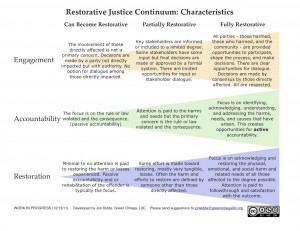As a response to earlier blog entries, Jon Kidde developed an RJ continuum and set of principles or indicators. With his permission, I am posting them as a guest entry. Jon welcomes feedback on these.
To see a larger version of the continuum, click here.
RESTORATIVE JUSTICE: principles and indicators
Engagement
Involve those impacted/affected, including the community, (i.e. victim, family, neighborhood, school, offender) in the resolution.
Engagement of person(s) harmed:
- Evidence that demonstrates the program provides meaningful invitations to participate (e.g. more than one personalized contact attempt. A single form letter would not demonstrate this).
- Evidence that demonstrates those harmed have the opportunity to provide input and reasonably shape the outcome. (engagement & restoration)
Engagement of person(s) who have caused harm:
- Evidence that demonstrates that the program actively involves participants in understanding the harm and related needs as well as their ideas and input in determining the agreements/outcome.
Community Engagement
- Evidence that demonstrates the program actively involves the community in the response to the needs illuminated/harm experienced by all parties.
Accountability
Encourage appropriate responsibility to address needs and repair the harm.
- Evidence that demonstrates the program ensures that the participants acknowledge responsibility for the harm caused.
- Evidence that demonstrates the program provides opportunities for the person who caused the harm to develop an understanding of how his/her actions affected others.
- Evidence that demonstrates the program facilitates the development of agreements that directly relate to repairing the harm as defined by those directly affected—victim and offender.
Restoration
Acknowledgement and repair of the harm caused by, and revealed by, wrongdoing.
- Evidence that demonstrates the program ensures that the participants acknowledge responsibility for the harm caused.
- Evidence that demonstrates completion of agreements focused on repairing the harm.
- Evidence that demonstrates satisfaction among those harmed with the outcome of the process used.
(Adapted from and influenced by Howard Zehr’s blog)
A bit of background on Jon:
Jon Kidde has been exploring the concepts of restorative justice for over 14 years and has been influential in the design and implementation of several programs based on restorative justice in Wyoming and California.
He has conducted research on the perspectives of youth, parents, victims, and community members who have interacted with the Juvenile Court. He enjoys facilitating strategic planning for organizations interested in increasing opportunities for collaboration, dialogue, and shared power and decision-making.
Jon is currently thinking broadly about how to effectively bridge the gap that exists between on the ground practices and (1) their foundationalprinciples, (2) governing policies, and (3) outcome evaluation research designed to inform practice.
Jon lives in Vermont with his wife, Heather, and daughter Lily Lyon. He currently supervises the implementation of a statewide initiative to enhance Court Diversion Programs in Vermont.


This is really excellent. Thanks for sharing this person’s work, Howard. I find these kind of continuums helpful both for sharing about the work of restorative justice, but also understanding what I’m offering when I facilitate it.
cheers,
judah